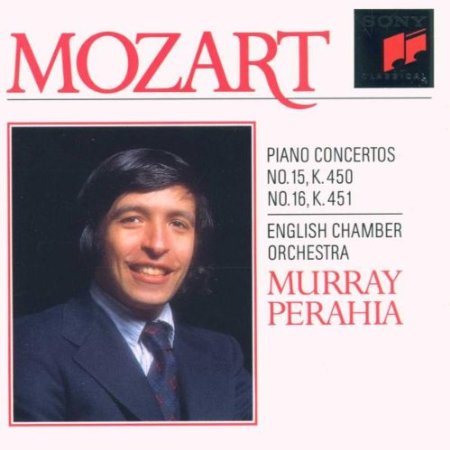Mozart Piano Concerto Nos 15 & 16
View record and artist detailsRecord and Artist Details
Composer or Director: Wolfgang Amadeus Mozart
Genre:
Orchestral
Label: Sony Classical
Magazine Review Date: 4/1984
Media Format: Vinyl
Media Runtime: 0
Mastering:
DDD
Catalogue Number: 37824

Tracks:
| Composition | Artist Credit |
|---|---|
| Concerto for Piano and Orchestra No. 15 |
Wolfgang Amadeus Mozart, Composer
English Chamber Orchestra Murray Perahia, Piano Wolfgang Amadeus Mozart, Composer |
| Concerto for Piano and Orchestra No. 16 |
Wolfgang Amadeus Mozart, Composer
English Chamber Orchestra Murray Perahia, Piano Wolfgang Amadeus Mozart, Composer |
Author: rgolding
''I really cannot choose between the two of them, but I regard them both as concertos that are bound to make the performer perspire. From the point of view of difficulty the Concerto in B flat beats the one in D.'' Mozart was writing to his father in May 1784 about the Piano Concertos in B flat, K450 and D, K451, both of them completed within the space of one week, in March that year.
I think most people would agree that K450, the first of his concertos to emancipate the wind instruments, with its beguiling first movement, its lovely variation-form Andante and its spirited 'hunting' finale, is a slightly better work than the more festive, but thematically less memorable, K451, despite the grandeur of its two fast movements, particularly the splendid, march-like opening Allegro assai. But surely even Mozart would have found it almost impossible to choose between the two performances recorded here, both of them outstanding good in their different ways.
Murray Perahia (who has just completed his recording of all the concertos, although several remain to be issued) gives intelligent, beautifully controlled, highly polished performances, and is especially successful in the more intimate, almost chamber-musical K450 and in the gently, simuous Andante of K451 (where he not only plays the ornamented version of bars 56-62 which Mozart obligingly wrote for his sister Nannerl—who found the original passage too plain—but also very rightly elaborates on the bare octaves in bars 75-6; Mozart doubtless decorated both passages during actual performance). Vladimir Ashkenazy, still with some concertos to go before completing his cycle, gives performances that are equally penetrating and perceptive, but which are more full-blooded, more conscious of the melodic line. He is thus inclined to take a few discreet liberties with the rhythm, lingering over a phrase here and there, and although he, too, plays Nannerl's variant in the slow movement of K451 (which he takes at a slightly quicker pace than Perahia), he plays bars 75-6 just as they are written.
To over-simplify, it could be said that Ashkenazy is more lyrical and spontaneous, Perahia more 'Classical' and contained; but the distinction is small and is emphasized in a direct comparison. The differences are underlined by the orchestral contribution and the recording: the Philharmonia sounding magnificently symphonic on Decca and altogether appropriate to K451, whose outer movements are done with tremendous panache; the ECO more deliberately scaled down and therefore marginally more appropriate to K450, and beautifully reproduced on CBS (on both LP and cassette—I have not heard the Decca cassette).
I should hate to have to make a choice between the two: the obvious answer is to get both.'
I think most people would agree that K450, the first of his concertos to emancipate the wind instruments, with its beguiling first movement, its lovely variation-form Andante and its spirited 'hunting' finale, is a slightly better work than the more festive, but thematically less memorable, K451, despite the grandeur of its two fast movements, particularly the splendid, march-like opening Allegro assai. But surely even Mozart would have found it almost impossible to choose between the two performances recorded here, both of them outstanding good in their different ways.
Murray Perahia (who has just completed his recording of all the concertos, although several remain to be issued) gives intelligent, beautifully controlled, highly polished performances, and is especially successful in the more intimate, almost chamber-musical K450 and in the gently, simuous Andante of K451 (where he not only plays the ornamented version of bars 56-62 which Mozart obligingly wrote for his sister Nannerl—who found the original passage too plain—but also very rightly elaborates on the bare octaves in bars 75-6; Mozart doubtless decorated both passages during actual performance). Vladimir Ashkenazy, still with some concertos to go before completing his cycle, gives performances that are equally penetrating and perceptive, but which are more full-blooded, more conscious of the melodic line. He is thus inclined to take a few discreet liberties with the rhythm, lingering over a phrase here and there, and although he, too, plays Nannerl's variant in the slow movement of K451 (which he takes at a slightly quicker pace than Perahia), he plays bars 75-6 just as they are written.
To over-simplify, it could be said that Ashkenazy is more lyrical and spontaneous, Perahia more 'Classical' and contained; but the distinction is small and is emphasized in a direct comparison. The differences are underlined by the orchestral contribution and the recording: the Philharmonia sounding magnificently symphonic on Decca and altogether appropriate to K451, whose outer movements are done with tremendous panache; the ECO more deliberately scaled down and therefore marginally more appropriate to K450, and beautifully reproduced on CBS (on both LP and cassette—I have not heard the Decca cassette).
I should hate to have to make a choice between the two: the obvious answer is to get both.'
Discover the world's largest classical music catalogue with Presto Music.

Gramophone Digital Club
- Digital Edition
- Digital Archive
- Reviews Database
- Full website access
From £8.75 / month
Subscribe
Gramophone Full Club
- Print Edition
- Digital Edition
- Digital Archive
- Reviews Database
- Full website access
From £11.00 / month
Subscribe
If you are a library, university or other organisation that would be interested in an institutional subscription to Gramophone please click here for further information.




